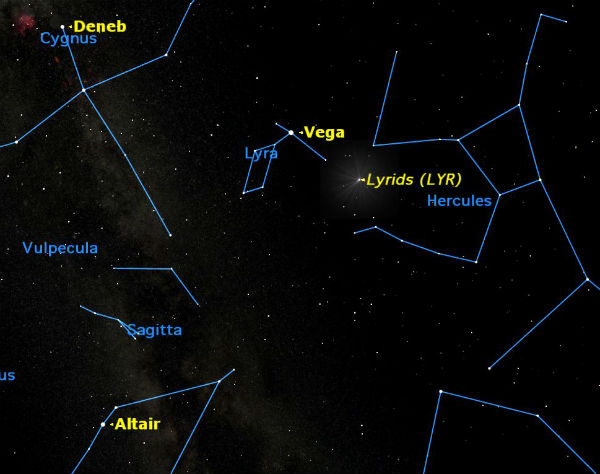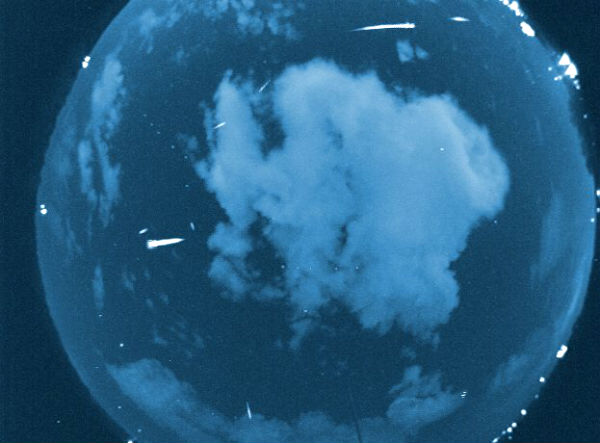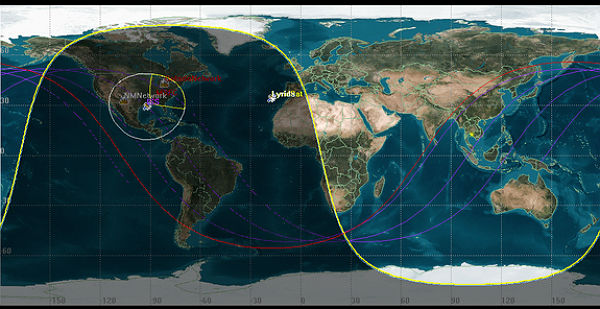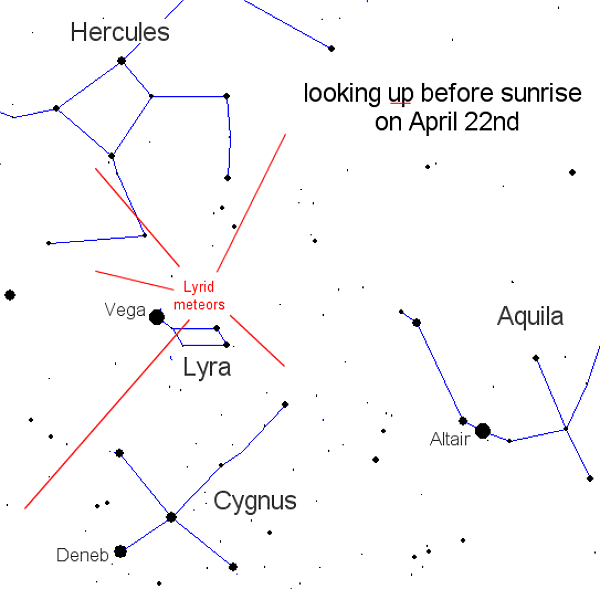A guide for skywatchers: 2012 Lyrid meteor shower

Each year the Earth passes through trail of Comet Thatcher (C/1861 G1) as it makes a 415-year highly elliptical journey around the Sun and have been observed for more than 2,600 years. The meteors from comet Thatcher occur when comet dust slams into Earth’s atmosphere at up to 110,000 mph (177,027 kph), igniting brilliant light displays. Each year the Lyrids start to build around April 16, peaking on April 21/22, and then fade away by April 26. At the peak, the Lyrids can deliver 10-20 meteors per hour. But there can also be spikes of activity, with more than 100 meteors per hour, as the Earth passes through clumps in the dust trail. This year meteor experts Dr. Bill Cooke estimates that the rate will be around 15 per hour.
This year’s Lyrids Meteor Shower coincides with a new Moon on April 21st which will set darker skies that are ideal for meteor watching. (Without the glare of a bright Moon, the meteors are easier to spot.)
Where to look?
The 2012 Lyrid meteor shower will be excellently seen from the entire northern hemisphere. You can see the shower from any spot on Earth, just head outside on the evening of April 21. Give your eyes time to adjust to the dark skies. Get out of the glare of a city if you can, to a dark enough location that you can see the Milky Way once the skies have fully darkened. If you can, try to time your viewing as late as possible, or even in the early morning, when the sky has fully darkened and the stars are really bright.
The last thing you want to do is look at Lyra, which is the direction of the radiant, because the meteors in that direction have very short tails and will appear as a dot to you. The best thing to do with any meteor shower is to go out there, lie on your back and look straight up.
Lyrids 2012: visual data quicklook
“NASA Up All Night” webchat
On Saturday, April 21, from 03:00 a.m. to 9:00 a.m. UTC (convert to your local time), meteor experts Dr. Bill Cooke, Danielle Moser and Rhiannon Blaauw from NASA’s Marshall Space Flight Center will answer questions about the Lyrids via a live Web chat.
(Click HERE a few minutes before 03 a.m. EDT on Saturday, April 21. The chat module will appear at the bottom of the page. After log in, wait for the chat module to be activated, then ask your questions!)
ALL-SKY CAMERA NETWORK
There will be alternate all-sky views being streamed from ALL-SKY CAMERA NETWORK . A live video feed from NASA’s all-sky camera network is available HERE.
In addition to the all-sky camera mounted at NASA’s Marshall Space Flight Center in Huntsville, Ala., you can also try some of the links below for excellent sky views. Please note that individual cameras have various refresh rates.

Sandia Sentinel Fireball Camera Network, El Paso, Texas
Sandia Sentinel Fireball Camera Network, Hawley, Texas
Oak Grove Observatory, Prairieville, La.
New Mexico Skies Observatories, Mayhill, N.M.
MMTO Sky Camera, Tuscon, Ariz.
Twin Pines Observatory, Belmont, Calif.
Lick Observatory All-Sky Camera, Mount Hamilton, Calif.
Meadow View Observatory, Chico, Calif.
Shane Observatory All-Sky Camera, Prince George BC, Canada
RASC Prince George Centre All-Sky Camera, Prince George BC, Canada
Paul Beskeen Astrophotography, Cambridgeshire, U.K.
Kiruna All-Sky Camera, Swedish Lapland

Lyrids 3D
In addition to live meteor camera views from the ground, astronomers at NASA’s Marshall Space Flight Center in Huntsville, Ala. and Dr. Tony Phillips of Science@NASA who runs the excellent skywatching website Spaceweather.com, are teaming up to seek a new dimension for Lyrid viewing. Dr. Phillips and a dozen students from Union High School and Home Street Middle School in Bishop, Calif., will launch a video camera on a balloon from 100,000 feet above Earth’s surface on the night of the Lyrids peak – hopefully to capture brilliant meteors burning up in the atmosphere from a vantage point well above the clouds. Meanwhile, an astronaut on the International Space Station will attempt to photograph the meteors from space.


You can tell if a meteor belongs to a particular shower by tracing back its path to see if it originates near a specific point in the sky, called the radiant. The constellation in which the radiant is located gives the shower its name, and in this case, Lyrids appear to come from a point in the constellation Lyra. Meteors can appear in any part of the sky, although their trails will tend to point back toward the radiant – toward Vega. Vega is a brilliant blue-white star about three times wider than our Sun and 25 light years away.
Usually the Lyrids produce only about a dozen meteors per hour under dark skies. In 1982 its peak intensity under ideal conditions (called the zenithal hourly rate) briefly reached 90. Other short outbursts have perhaps gone unnoticed, and there’s always a slim chance of something extraordinary. According to a Chinese chronicle, in 687 B.C. Lyrid meteors “dropped down like rain.”
Featured image credit: Starry Night Software



Around 10:20 pm tonight, Friday, April 20, 2012 I saw a beautiful, large comet very low and close up! It was partly blue inside (!) with a red, yellow & orange glow and a long, glowing tail. This was in Los Molinos, California. I had never seen one so big or close before! It was utterly enchanting! Instead of moving swiftly straight past, it seemed to wobble, like it was partly filled with water molecules. It looked light, not heavy and kind of translucent. The size amazed me. From my viewpoint, it appeared to be at least the size of a basketball! It looked like it was less than 20 yards away and below the top of our pecan tree, which was only 25 feet away from me. It traveled fairly horizontally with a gradual descent and looked almost playful. I thought it might hit our house. My husband and son were in the hot tub with me when I saw it but all they witnessed was a very bright light. The reflection was so bright that they thought someone was coming around the corner in our yard towards us with an exceptionally bright flashlight. I never noticed a reflection. My husband got a sheer glimpse of the source of the light for a split second as it disappeared behind a nearby tree.
I am 58 years old and although I’ve seen many falling stars, and some comets & meteor showers in my life, I’ve never witnessed something so utterly spellbinding, so close up and wondrous!